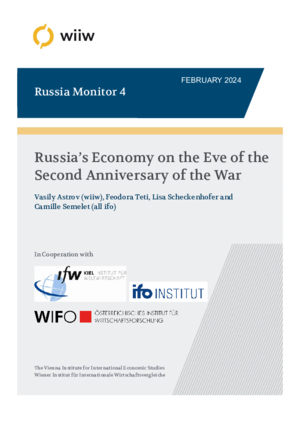Russia’s Economy on the Eve of the Second Anniversary of the War
Vasily Astrov, Lisa Scheckenhofer, Camille Semelet and Feodora Teti
Russia Monitor No. 4, February 2024
22 pages including 5 Figures and 1 Box
Nearly two years after the start of the war in Ukraine, the report gives an overview of the current state of the Russian economy, with a focus on the fiscal situation, external balances, and the effects of Western sanctions on Russia’s trade with the EU and selected third countries. Increased scrutiny of companies from third countries violating the energy sanctions led to a renewed widening of the price discount on Russian oil during the last few months of 2023. However, despite this and heavy military spending, last year’s fiscal deficit was kept under control and primarily covered from the sovereign National Welfare Fund. EU exports to Russia of sanctioned economically critical (EC) goods and common high-priority (CHP) items have virtually stalled, indicating that the sanctions are effectively preventing direct exports. However, third countries, notably China, Hong Kong, Türkiye and the CIS countries, have increased their market shares and become Russia’s most important suppliers of missing EC goods and CHP items. Our findings suggest a particularly high likelihood of sanctions evasion via such CIS countries as Armenia, Kazakhstan, Uzbekistan and Kyrgyzstan, and to a lesser extent via Türkiye and China.
Keywords: sovereign fund, energy sanctions, economically critically goods, common high priority items, trade sanctions, sanctions evasion
JEL classification: F14, F51, H6
Countries covered: Russia
Research Areas: Macroeconomic Analysis and Policy, International Trade, Competitiveness and FDI
